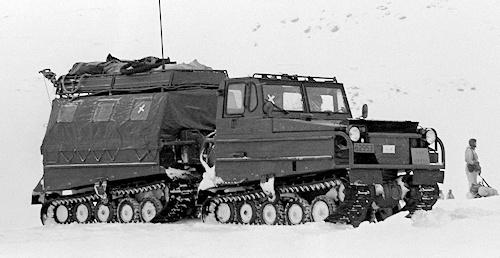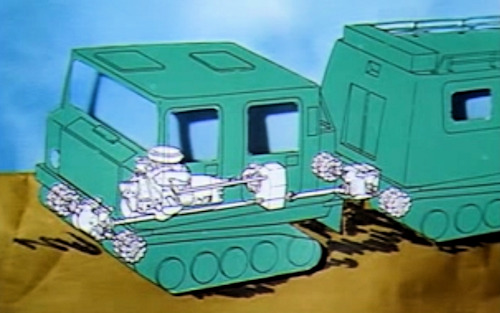It is little in sight and consequently little is said about it, but this Swedish vehicle still supplied to the Alpine troops has been on mission in various operational theaters, including Afghanistan, Kosovo and Iraq. Not only that, thanks to its mobility characteristics it has been appreciated especially in the civil field to deal with snow emergencies.
We are talking about the BV 206 bimodular crawler tank. Our army's first orders date back to the 80s when it was produced by the Scandinavian company Hägglunds & Söner, now an integral part of the UK defense industrial complex, BAE Systems.
There are many memories associated with this wagon during the lever as different were the more or less witty nicknames that were attributed to him.
What struck me most was the concept of a crawler with a trailer and the fact that it had a steering wheel rather than two levers for steering, as in the case of the VTT M113 crawler. The conductor was therefore not defined as a "real truck" and the healthy rivalry between departments was felt in joint operations.
 The BV206 project dates back to 74 for the replacement of the 202 series (photo). The vehicle entered service in several armies and relief organizations. In our Army, provided the sources are reliable, there would be ninety BV85 versions since 206, mostly converted with a diesel engine, while since 2002 there should be about a hundred BV206S7 versions, some adapted with the radar system. Arthur.
The BV206 project dates back to 74 for the replacement of the 202 series (photo). The vehicle entered service in several armies and relief organizations. In our Army, provided the sources are reliable, there would be ninety BV85 versions since 206, mostly converted with a diesel engine, while since 2002 there should be about a hundred BV206S7 versions, some adapted with the radar system. Arthur.
However, the next 206S version was more successful at the Canadian and US armies, despite some limitations that penalized its operational use compared to modern wheeled or crawler armored vehicles and above all amphibious ones.
How is it done and why it does not convince?
The performance of the 206 and 206S compared to recent military vehicles - and it could not be otherwise - are a bit 'its limitation with only 55 km / h speed and power that over time have passed from 134 horses to 185.
The major flaw probably lies in not having amphibious characteristics of buoyancy and mobility in water: although it has the possibility of diving up to a little more than one meter, in the event of a sudden difference in height this means would remain out of use unlike the new multirole amphibious type ( light or protected) tracked or rotated - widely proposed at Eurosatory 2018 - and present on the market today.
 The first versions of the 206 were equipped with an Austrian petrol-driven Steyr engine, then a diesel-aspirated Mercedes-Benz OM603.950 6 diesel V-cylinder of 3.0 cc with two valves per cylinder and with 140 hp for just over six tons of mass to move. A little power and a "woody" engine like the aspirated diesels, but thanks to the gear ratios the throttle response was satisfactory.
The first versions of the 206 were equipped with an Austrian petrol-driven Steyr engine, then a diesel-aspirated Mercedes-Benz OM603.950 6 diesel V-cylinder of 3.0 cc with two valves per cylinder and with 140 hp for just over six tons of mass to move. A little power and a "woody" engine like the aspirated diesels, but thanks to the gear ratios the throttle response was satisfactory.
A part of the engine worked as a hydraulic pump for the servo controls. The engine, as for the trucks, was centrally located in the cabin between driver and capomacchina, and only a quarter of its volume was present inside, considering its height of 2,4 meters. Little soundproofing and instrumentation clearly derived from Mercedes Benz, however, guaranteed simplicity and reliability in the most drastic use but often the engine compartment was flooded.
The engine was coupled with the Allison automatic gearbox to 4 gears, from which a short drive shaft was inserted into a torque / gearbox divider, always in line with the engine. Two transmission shafts were coming from the lower part of the distributor, one directed at the differential of the front axle and the other at the differential of the first axle of the trailer. In fact the trailer, thanks to this solution - also used in agricultural machines between tractor and combine harvester - guarantees to the towed track module its traction driven but with a speed probably lower than the tractor.
 At the end of the front axle shafts of the tractor there is a hydraulic-driven planetary unit which, on the basis of the steering portion set by the steering wheel, regulates the hydraulic oil pressure necessary for the operation of the belt clutches or drum brakes and therefore of the relative autonomous rotation speed of the rubber tracks. The 206 has two roof hatches on the roof while in the armored 206S7 there is only one with horizontal sliding opening.
At the end of the front axle shafts of the tractor there is a hydraulic-driven planetary unit which, on the basis of the steering portion set by the steering wheel, regulates the hydraulic oil pressure necessary for the operation of the belt clutches or drum brakes and therefore of the relative autonomous rotation speed of the rubber tracks. The 206 has two roof hatches on the roof while in the armored 206S7 there is only one with horizontal sliding opening.
As crawler All-Terrain it is also limited to the ease in transiting on critical slopes, about 31 ° frontally passed later with the BV 206S to 40 ° and this is partly due to the poor articulation between the two modules, from the jolts between the two masses, and their short length . However, if the drive module goes ahead while being in front, the rear module could provide, by inserting the reverse gear, to tow the vehicle out of a difficult situation. However, this involves transit in critical passages at very low operating speeds.
Traveling in the troop transport trailer is not exempt from strong shaking while the tractor is much more stable, which houses only 5 seats.
Its autonomy is only 300 kilometers but interesting are the technical configurations, including the sanitary, which can be set up inside and the interesting total space for the transport of well 17 military.
It is a little less than seven meters long by 1.87 meters wide and perhaps just the small measures of the unprotected BV206 pose limits of balance in the heavy transits.
 Criticized but useful
Criticized but useful
For someone it was a vehicle that had to be put into force more to make number compared to the real possibilities of employment. A story perhaps already known in the Alps with the carts used for Mulo Meccanico (v.articolo). At the armored 206S BV it was still better to the point that it is still in service in our Army an updated version with 182 hp and Td engine and a towing potential equal to 2.5 tons for 7.6 meters of overall length and 2.34 meters wide. Features certainly more suitable for operational use.
The greater section of the tracks and a greater width of the vehicle with a different engine layout, are the characteristics that have re-launched the valid project of our mud climber and snows that in the BV206S7 version is armored.
The Turin ARIS with the ARK model (v.articolo) produces similar vehicles with interesting and above all amphibious characteristics and performances.
It is worth mentioning the commendable work of our Army with the Alpini and the BV 206 / 206S to clear the roads during the heavy snowfall of the 2015 at Campotosto AQ during the snow emergency.
The BvS10 evolution
 Similar but significantly improved and increased compared to the BV 206S, this wagon of BAE Systems has as its main distinguishing feature compared to the previous, the possibility of being amphibious. In fact, the water can reach 5 km / h and the whole structure is armored for a total weight of 8.5 tons and a payload doubled to 5 tons compared to the previous 206. On the road its speed is 65 km / h and its American Cummins engine from 5.9 cc delivers 275 horses. It can carry military 13 and the configurations are called: TCV Troop Carrying Variant - variant of troop transport - the CV Command Variant - command variant - the RRV Recovery Repair Variant - variant recovery and repair - and health with the AV Ambulance Variant. It is not in service in our Army, but exposed at the company Goriziane Group SpA, of Villesse in the province of Gorizia, the same company that takes care of the maintenance of the 206S still in force in the Army.
Similar but significantly improved and increased compared to the BV 206S, this wagon of BAE Systems has as its main distinguishing feature compared to the previous, the possibility of being amphibious. In fact, the water can reach 5 km / h and the whole structure is armored for a total weight of 8.5 tons and a payload doubled to 5 tons compared to the previous 206. On the road its speed is 65 km / h and its American Cummins engine from 5.9 cc delivers 275 horses. It can carry military 13 and the configurations are called: TCV Troop Carrying Variant - variant of troop transport - the CV Command Variant - command variant - the RRV Recovery Repair Variant - variant recovery and repair - and health with the AV Ambulance Variant. It is not in service in our Army, but exposed at the company Goriziane Group SpA, of Villesse in the province of Gorizia, the same company that takes care of the maintenance of the 206S still in force in the Army.
It is not excluded that similar vehicles can enter the barracks of the Alpine, however the same rubberized 8X8 with the addition of snow chains or the modern VCC transport troop with alloy surfaces, although more cumbersome, are placed for performance at a level probably higher to the concept of bi-vehicular tracked vehicles.
A thought to the dissolved 33 ° terrestrial artillery regiment Acqui - "High the honor we kept" - occurred in June of 2013, its commanders and all the military, who since the beginning of January 1915 with their sacrifice and dedication have made the history of this prestigious department of the Italian Army. The barracks now host the 9 ° rgt alpine troops, and probably some versions of the BV206 and 206S7 are present under the sheds of their self-rig.

(photo: web / BAE Systems / Defense)












